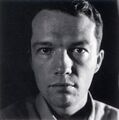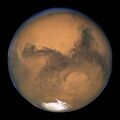Template:Selected anniversaries/August 27: Difference between revisions
No edit summary |
No edit summary |
||
| (7 intermediate revisions by the same user not shown) | |||
| Line 5: | Line 5: | ||
||1783: The first experimental hydrogen-filled balloon left the Champs de Mars, Paris, unmanned, and reached 900-m altitude. Under the auspices of the French Academy of Sciences, Jacques A.C. Charles sent up a 13-ft (4-m) diameter hydrogen- filled balloon of rubber- coated silk. One of the spectators was the American ambassador to France, Benjamin Franklin. The gas had been manufactured, beginning on 23 Aug 1783, by pouring 225-kg of sulphuric acid over half a ton of scrap-iron. Able to lift about 9-kg, it traveled 24-km in about 45 minutes. The balloon descended close to the little village of Gonesse, where frightened local farmers attacked it with pick axes and spades, leaving only torn remains. | ||1783: The first experimental hydrogen-filled balloon left the Champs de Mars, Paris, unmanned, and reached 900-m altitude. Under the auspices of the French Academy of Sciences, Jacques A.C. Charles sent up a 13-ft (4-m) diameter hydrogen- filled balloon of rubber- coated silk. One of the spectators was the American ambassador to France, Benjamin Franklin. The gas had been manufactured, beginning on 23 Aug 1783, by pouring 225-kg of sulphuric acid over half a ton of scrap-iron. Able to lift about 9-kg, it traveled 24-km in about 45 minutes. The balloon descended close to the little village of Gonesse, where frightened local farmers attacked it with pick axes and spades, leaving only torn remains. | ||
||1784: James Tytler made the first balloon ascent in Britain in a hot-air balloon at | File:James_Tytler.jpg|link=James Tytler|1784: Apothecary and editor [[James Tytler (nonfiction)|James Tytler]] made the first balloon ascent in Britain in a hot-air balloon at Edinburgh, Scotland. Before a small number of onlookers, the balloon rose to 350 feet in the air, travelled half a mile, and landed in Restalrig village. | ||
||1850: Augusto Righi born ... physicist and a pioneer in the study of electromagnetism. Pic. | ||1850: Augusto Righi born ... physicist and a pioneer in the study of electromagnetism. Pic. | ||
| Line 52: | Line 52: | ||
||1929: Herman Potočnik dies ... rocket engineer and pioneer of cosmonautics (astronautics). He is chiefly remembered for his work addressing the long-term human habitation of space. Pic. | ||1929: Herman Potočnik dies ... rocket engineer and pioneer of cosmonautics (astronautics). He is chiefly remembered for his work addressing the long-term human habitation of space. Pic. | ||
||1939: Östen Mäkitalo born ... engineer and academic dies ... Nordic mobile. Pic search. | ||1939: Östen Mäkitalo born ... engineer and academic dies ... Nordic mobile. Pic search. | ||
| Line 82: | Line 80: | ||
File:Dennis_Paulson_of_Mars.jpg|link=Dennis Paulson of Mars|2017: ''[[Dennis Paulson of Mars]]'' wins Pulitzer Prize for Best Reality Television Show. | File:Dennis_Paulson_of_Mars.jpg|link=Dennis Paulson of Mars|2017: ''[[Dennis Paulson of Mars]]'' wins Pulitzer Prize for Best Reality Television Show. | ||
</gallery> | </gallery> | ||
Latest revision as of 13:25, 7 February 2022
1784: Apothecary and editor James Tytler made the first balloon ascent in Britain in a hot-air balloon at Edinburgh, Scotland. Before a small number of onlookers, the balloon rose to 350 feet in the air, travelled half a mile, and landed in Restalrig village.
1858: Mathematician Giuseppe Peano born. He will do pioneering work in mathematical logic and set theory.
1915: Physicist Norman Foster Ramsey Jr. born. He will be awarded the 1989 Nobel Prize in Physics for the invention of the separated oscillatory field method, which will have important applications in the construction of atomic clocks.
1926: Chemist and composer George Brecht born. He will be a conceptual artist and avant-garde composer, as well as a professional chemist who will work as a consultant for companies including Pfizer, Johnson & Johnson, and Mobil Oil.
2003: Mars makes its closest approach to Earth in nearly 60,000 years, passing 34,646,418 miles (55,758,005 km) distant.
2017: Dennis Paulson of Mars wins Pulitzer Prize for Best Reality Television Show.





